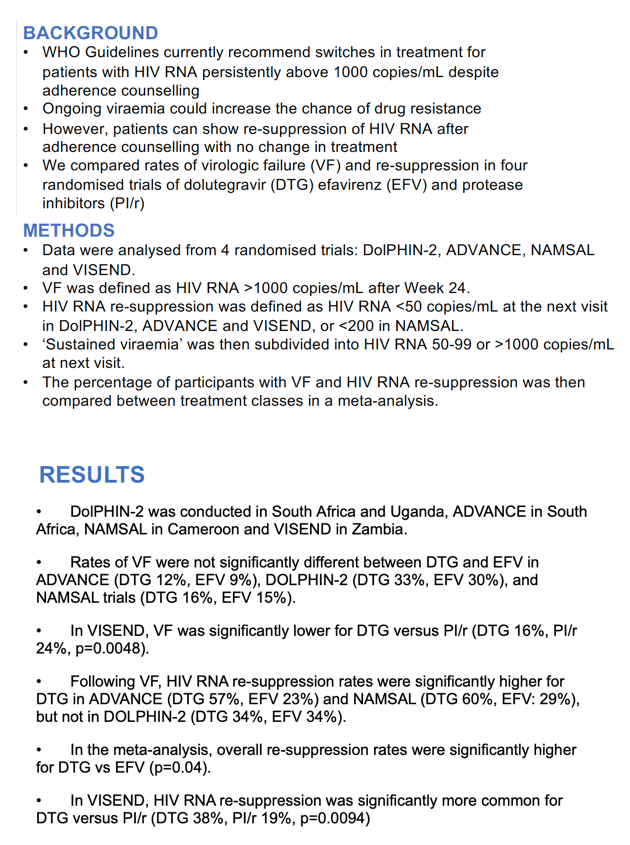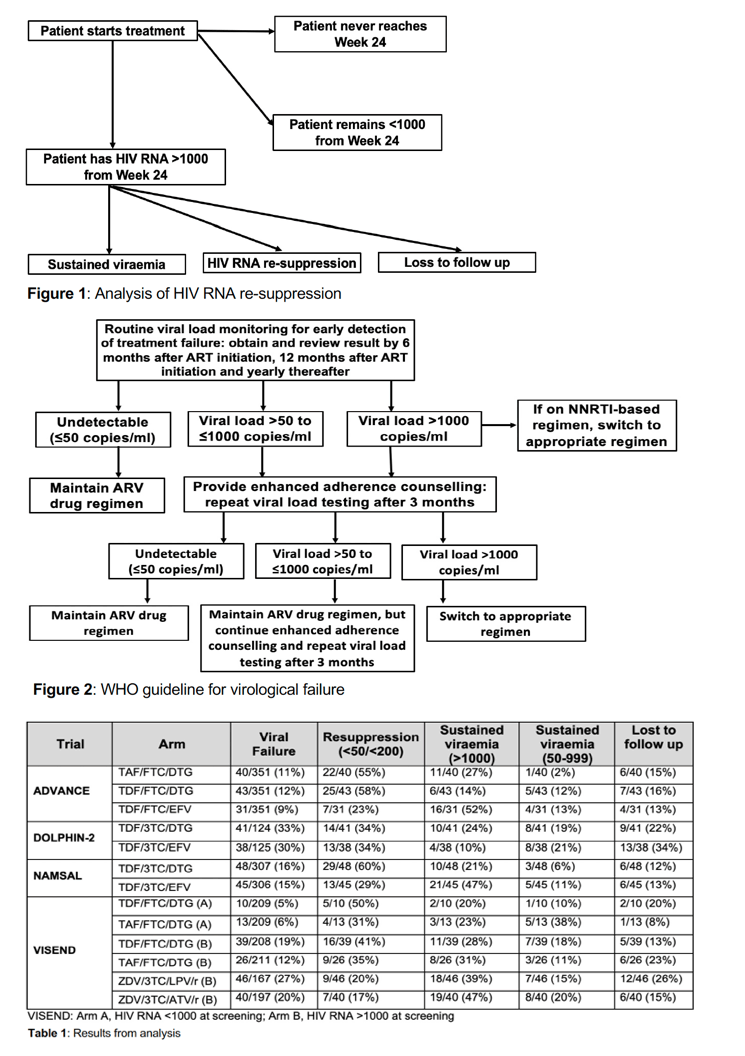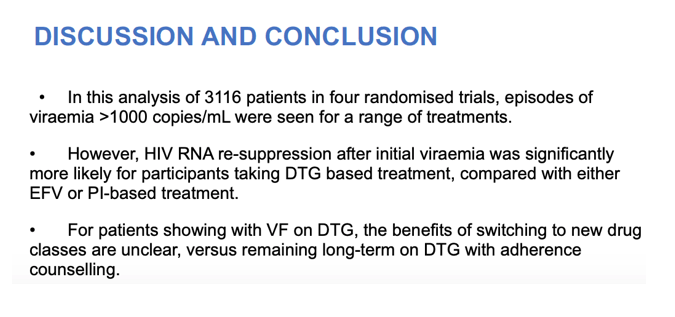 |
 |
 |
| |
DTG Better Than PI or EFV for Resuppression
of HIV After Apparent Virologic Failure in 4 African Trials
|
| |
| |
HIV Drug Therapy Glasgow, October 23-26, 2022
Mark Mascolini
In four randomized African trials involving 3116 people with HIV, 24-week virologic failure rates did not differ substantially between regimens built on the integrase inhibitor dolutegravir (DTG), the nonnucleoside efavirenz (EFV), or a ritonavir-boosted protease inhibitor (PI/r) [1]. But DTG held a significant advantage in resuppression of HIV after a viral load above 1000 copies. The findings pose a conundrum: After "failure" of DTG, should clinicians switch to another drug or stay with DTG and redouble efforts to improve adherence?
Researchers in South Africa, Cameroon, and Zambia, where the trials occurred, collaborated with European colleagues to compare rates of virologic failure (a viral load above 1000 copies after trial week 24) and resuppression in four randomized African trials: (1) DolPHIN-2 compared DTG and EFV in South Africa and Uganda [2]. (2) ADVANCE also pitted DTG against EFV in South Africa [3]. (3) NAMSAL compared the same two antiretrovirals in Cameroon [4]. And (4) VISEND studied DTG versus PI/r in Zambia [5]. In all, these trials included 3116 people for analysis. Virologic failure meant a viral load above 1000 copies after trial week 24, and resuppression meant a viral load below 50 copies at the next visit in DolPHIN-2, ADVANCE, and VISEND or below 200 copies in NAMSAL.
Virologic failure rates did not differ significantly between DTG and EFV in DolPHIN-2 (33% and 30%), ADVANCE (12% and 9%), or NAMSAL (16% and 15%). In VISEND the virologic failure rate was significantly lower with DTG than PI/r (16% vs 24%, P = 0.0048).
After virologic failure, DTG resuppressed HIV significantly more often than EFV in ADVANCE (57% vs 23%) and NAMSAL (60% vs 29%) but not in DolPHIN-2 (34% and 34%). Meta-analysis of these three trials determined that overall virologic resuppression was significantly more frequent with DTG than EFV (P = 0.04). In the VISEND trial, DTG resuppressed HIV significantly more often than PI/r (38% vs 19%, P = 0.0094).
The researchers concluded that virologic failure affected "a range of treatments" in these four randomized African trials. But DTG resuppressed HIV more often than EFV or a boosted PI in three of these four studies of more than 3000 people. The researchers ventured that for people with virologic failure of a DTG regimen, "the benefits of switching to new drug classes are unclear" when compared with retaining DTG and fortifying adherence counseling.
Reference
1. Venter F, Sokhela S, Bosch B, et al. Virological failure and HIV RNA re-suppression rates in four randomised trials of dolutegravir, efavirenz or protease inhibitor-based treatment in 3116 participants. HIV Drug Therapy Glasgow, October 23-26, 2022.
2. Kintu K, Malaba TR, Nakibuka J, et al; DolPHIN-2 Study Group. Dolutegravir versus efavirenz in women starting HIV therapy in late pregnancy (DolPHIN-2): an open-label, randomised controlled trial. Lancet HIV. 2020;7:e332-e339. doi: 10.1016/S2352-3018(20)30050-3.
https://www.thelancet.com/journals/lanhiv/article/PIIS2352-3018(20)30050-3/fulltext
3. Venter WDF, Sokhela S, Simmons B, et al. Dolutegravir with emtricitabine and tenofovir alafenamide or tenofovir disoproxil fumarate versus efavirenz, emtricitabine, and tenofovir disoproxil fumarate for initial treatment of HIV-1 infection (ADVANCE): week 96 results from a randomised, phase 3, non-inferiority trial. Lancet HIV. 2020;e666-e676. doi: 10.1016/S2352-3018(20)30241-1. https://www.thelancet.com/journals/lanhiv/article/PIIS2352-3018(20)30241-1/fulltext
4. Calmy A, Tovar Sanchez T, Kouanfack C, Dolutegravir-based and low-dose efavirenz-based regimen for the initial treatment of HIV-1 infection (NAMSAL): week 96 results from a two-group, multicentre, randomised, open label, phase 3 non-inferiority trial in Cameroon. New Antiretroviral and Monitoring Strategies in HIV-infected Adults in Low-Income Countries (NAMSAL) ANRS 12313 Study Group. Lancet HIV. 2020;7:e677-e687. doi: 10.1016/S2352-3018(20)30238-1. https://www.thelancet.com/journals/lanhiv/article/PIIS2352-3018(20)30238-1/fulltext
5. Clinical Care Options HIV. VISEND: Switching From NNRTI-Based to PI-Based ART vs DTG + Recycled NRTIs Source: Conference Coverage of CROI 2022: Clinical Impact of New HIV Data. February 13-16, 2022; Virtual. https://www.clinicaloptions.com/hiv/conference-coverage/2022/retroviruses-2022/clinical-impact-of-new-hiv-data/capsule-summary-slidesets/135



|
| |
|
 |
 |
|
|